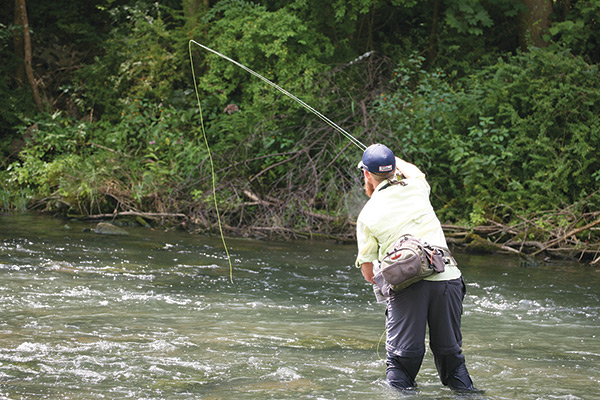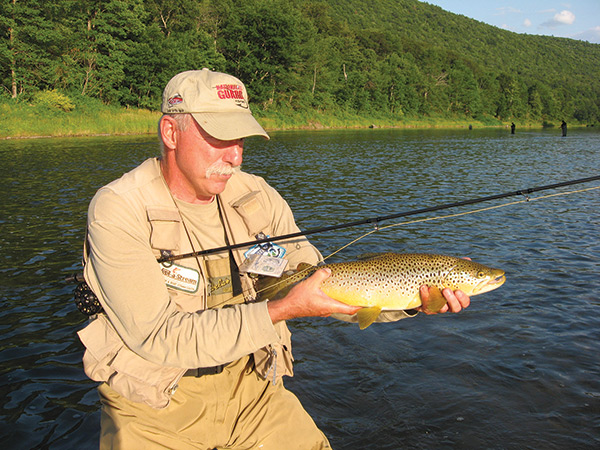 Fish & Tackle: Foam is Home for Trout
Fish & Tackle: Foam is Home for Trout
By Vic Attardo

I’ve always lived by the rule, “It’s better to be humble in the tackle shop than fishless on the river.” In other words, if you’re not catching fish, stuff your pride and ask questions. T
he rule applies to tackle and fly shops as well as folks you encounter on the water who are obviously having a better day. You see them consistently nailing fins while your net remains conspicuously empty.
I was on the Middle Fork South Platte River, in Colorado, and it was, for many hours, an empty net day. Beside the river’s name being a mouthful, this was my first time on this famous trout flow, and I needed help. Upstream I could see a young lady enjoying a succession of bent rods and a throbbing net. Simply put, she was hooking and landing trout while I wasn’t. A little disgusted, I hiked back to my truck for a tailgate lunch and to lick my ego-shattered wounds.
As it is happened, the successful angler must have felt it was time for a break (and perhaps some celebration) as she also left the water. Her van was parked near my truck and when she opened the van’s rear doors I could see from the layout and all the equipment inside, she was a very serious angler. It looked to me that her life revolved around fishing, fly fishing to be exact. Rod holders were attached to the van’s ceiling and walls, a neat array of tackle bags were stacked on homemade shelves, there was a makeshift table that held a fly tying vise and labeled boxes of fur and feathers. The van was also decked out with roof hangers for waders, and mats for wet boots. Anything that detracted from her serious pursuit was irrelevant. It was my first encounter with what I respectfully call “a trout bum.” No bones about it, I admired her.
Enjoying a hot lunch of beans, rice and smoked sardines I thought of my life-long rule and got up the nerve to ask what she was doing to catch so many trout.
“Foam is home,” was all she said when I asked her the obvious question. Then she got in the driver’s seat and sped away.
To make this long story shorter, after lunch I went back to the South Platte walked along the steep shoreline until I saw an area where white specks of foam were concentrated along a bank, made a cast and hooked my first of a couple of that afternoon’s chunky rainbow trout. I quickly learned that on the South Platte, foam was indeed home. By the end of the day all but one of my fish came from spots where a concentration of flat white bubbles skidded along the surface.
And now, dear lady, whoever you were, I must apologize. I’ve stolen the line, “Foam is home” from you over and over. Having other anglers approach me after I’ve been seen catching trout when they weren’t, when asked, I said, “Foam is home.”
So, what is the foam I’m referring to and why is it home for so many trout.
Well, this foam is not a case of horrendous pollution. This is clean water foam. I’ve seen the caramel-colored bubbles that stack up like dirty mountains and not only am I loathe to fish those spots, but they’re not the foam that is home.
Instead, the glittering flat white bubbles I like are created simply by the agitation of water. You can make foam in a cup by stirring the water with a straw or you can make it in the sink by madly swishing the water around. Good foam is created by adding oxygen to the water. In an artificial environment the good foam dissolves quickly, but along a natural water course the foamy bubbles drift along for yards and yards before breaking apart.
The question I had to ask myself when I saw how universally foam was home to trout was why?
Once I had an on-stream discussion with a couple of anglers as they were studying the foam in front of them and to a man they answered, “There’s more oxygen there and the fish like breathing it.”
Wrong. There is no way the fish could instantly feel the benefit of increased oxygen as small islands of foam floated by. Foam is home but it has nothing to do with oxygen at all. What a layer of foam, or dispersed bubbles, is all about is natural cover and food acquisition.
Fishing the famous Beaverkill River in southeastern New York, I watched as a mature Bald Eagle flew down from a tree to grab a good size trout. As the bird took off with the fish firmly grasped in its talons, I noticed, among other things, that the attack took place in a smooth tailout away from any foam. The captured trout had made the fatal mistake of setting up shop in the open without any form of cover or aerial camouflage. About the same moment a trout rose in a section of water the eagle had avoided. The bird might have gone for that rising fish in equally shallow water but didn’t. A thin layer of foam provided cover for the feeding fish. And that is one of two key reasons why foam is home for so many trout. The bubbles provide protection from sky-borne predators. The trout hides under the layer of floating bubbles and though this protection seems thin, the bubbles work.
Now, you might say there is no way a layer of bubbles or foam is going to prevent an aerial predator from seeing and attacking a fish, but look twice. If it’s a nice sunny day, the bubbles are also throwing clumps of shadows on the stream bottom. The movement of those shadows present a confusing picture to an aerial predator. It just adds up that the winged harassers would look to another piece of water to make a grab.
The second reason foam is home for so many trout is that the bubbles trap and encase surface-floating insects. Sometimes the bugs float beside a cluster of bubbles, sometimes they’re trapped inside the foam. Whatever the specific condition, trout will rise to the bugs, and that makes foam a good feeding zone. When a raft of foam is circulating around an eddy, the slower-moving foam becomes a prime feeding place for rising trout.
Targeting foam patches is not just confined to large streams and rivers, many times foam over smaller flows with otherwise limited cover provide trout fine habitat for protection and feeding.
I like to visit fly fishing friends in the upper Midwest and travel to a superb small stream in Wisconsin’s Driftless Area with the colorful name of Timber Coulee. This thin stream runs through fenced meadows, meandering slower than a frozen snake. On several visits, I found my best chances lay at the riffles and broken water with the scattered foam playing an important role, particularly during the long Midwest evenings with a barrage of biting insects.
A fly known locally as the Greased Lightning is a parachute midge pattern made with a pink-colored post. I make a slight variation that includes a pink or bright orange Antron post – Antron for stiffness – and a few wisps of light grey CDC for movement. The Greased Lightning and its cousin, the High Viz Klinkhammer, also a parachute midge, are generally intended for use in winter and early spring. But if you switch out the thin green body of the Greased Lightning for a thread body of twisted white and black thread you get a perfect mosquito imitation that’s good all summer.
It was on a Driftless trip, when the water was low and the sun was bright, that a buddy and I were both rescued and harassed by mosquitoes. We went down to Timber Coulee about an hour before sunset and searched a good half mile of stream until we found two stretches that were unoccupied by other anglers. These waters wouldn’t have been our first choices, but I often prefer solitude and challenge to tight quarters. The section I got to fish was a compact but gnarled piece of water bordered by blunt, heavily wooded hills. As the sun sank behind those low forested humps the mosquitoes came out like an evil Air Force.
Timber Coulee trout are smart. Perhaps on cloudy or rainy days they will rise anywhere along the water course, but when the sky is bright, even with a descending sun, they look for a rumbled ceiling for food and cover, and if that space contains foam bubbles, it’s often the best spot on the stream for rising trout.
On this evening, I had a slice of water where limited foam ran tight to the bank. Wearing a camouflage jacket, I knelt on the opposite side of the stream from the foam and watched. Pretty soon, three trout – all browns – were nosing out of the water. They came up between the bubbles and took a variety of tiny insects but were particularly voracious when a low flying cloud of mosquitoes drifted along. I tied on a pink-post Greased Lightning and timed my first cast to the floating foam. My fly landed on the edge of a small raft of bubbles and was immediately taken in by a brown.
Since foam is often the best feature in thin water, I waited a few minutes after landing the fish – giving the short stretch time to calm down – and let the next cast once again settle on the side of slow, meandering bubbles. The fly’s pink post stood out amid the sunset colors but apparently it didn’t stop the next brown from rising to the fly. Two casts, two trout.
After that 14-incher, I whistled to my buddy upstream, motioned that he should make a wide bypass of the stream bank and come down to my position. When he got close, I told him to kneel – often the best way to fish Timber Coulee and other small streams – and he placed his own Greased Lightning into the bank-edging foam.
Of course, a lot of things were right about this spot. Not only the cover-providing bubbles on the surface, but there was also a long trench along the bank making the stream an extra 6 inches to a foot deeper. With typical hydrology, the two often go hand in hand, foam and slightly deeper water.
My Midwest friend laid out a perfect fly into the soup and an 18-inch brown was not hesitant. I got to watch the fight which both angler and trout performed perfectly.
Certainly, bubbles and foam are good for offering trout minuscule insects other than midges and mosquitoes. Often foam will ensnare ants and beetles that have died and fallen. With winged ants, I’ll place a fly so that it rides slightly down stream with the tide, gets caught in a mishmash of circular current and is trapped on the surface like a ship caught in a whirlpool. From somewhere under the foam a previously unseen trout rises into the soup and my fly goes down with a silent slurp. Not the easiest thing to accomplish because trout will avoid anything that does not follow a prescribed path, but these trout are often fat and juicy from the lack of exertion needed to get food. I have not forgotten a 20-inch rainbow that appeared in a Pennsylvania eddy where previously I had never caught anything near its size.
So, dear Colorado lady, I want to thank you for that succinct piece of information you offered. I’ve piled up a lot more examples and memories, and you were indeed right, “Foam is home.”
